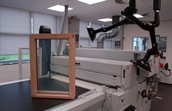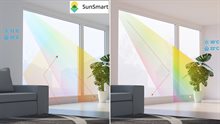SunSmart
Only with sustainable innovations is an energy- and climate-neutral built environment possible by 2050. SunSmart smart windows from TNO can significantly reduce the energy consumption of homes. A thermochromic coating keeps solar heat out in the summer and lets it in during the winter. This allows an average household to save 5-9% on their annual energy bill.
The Netherlands has over 7 million buildings, which together currently account for 40% of our energy consumption. Additionally, the built environment is responsible for nearly one-third of CO2 emissions. To meet the requirements of the Paris Climate Agreement, all homes and offices need to undergo significant sustainability improvements.
The intended end result is an energy- and climate-neutral built environment by 2050. To achieve this, innovations are needed that help reduce energy consumption. In addition to solar panels and heat pumps, smart windows will soon be able to make an important contribution to energy and emission reduction.

Air conditioning and heating can be turned off more often
TNO is currently working on the SunSmart smart window, which is equipped with a special coating. This thermochromic coating helps regulate the indoor temperature by blocking solar heat in the summer and allowing it in during the winter. As a result, smart windows can reduce the use of air conditioning and heating, thereby lowering energy consumption. An average household can save several hundred euros (around €500) annually on their energy bill with this innovation.

When the outside temperature is high, solar heat is blocked. As soon as the window temperature drops below a certain value, heat is allowed through.
This makes the windows smart
What is special about the SunSmart smart windows developed by TNO is that the thermochromic coating autonomously switches at a fixed temperature between allowing and blocking solar heat. The ability of the SunSmart smart windows to switch is an intrinsic property of the coating material, which has been optimized for use in transparent insulating glass after years of research.
Advantages compared to existing solar control glass coatings
SunSmart windows, like solar control glass, block heat in the summer without changing the transparency or color of the window. This saves on air conditioning energy, reduces heat stress, and increases comfort by maintaining lower temperatures and sufficient daylight.
The major advantage compared to solar control glass is that SunSmart switches, allowing solar heat through at lower temperatures (while solar control glass always blocks solar heat). This way, you can make optimal use of solar heat during other seasons, using it to reduce heating needs. The SunSmart smart windows that TNO is working on are affordable and feature integrated temperature regulation. Additional (electrical) connections or potentially replacing window frames are not required, increasing applicability for architects.
This is how smart windows work.
The smart windows are equipped with a temperature-sensitive glass coating made of vanadium dioxide mixed with other ingredients. Depending on the temperature, this layer either lets through or blocks infrared light from the sun.
If the outside temperature is below 21 degrees Celsius, the smart window allows solar heat to pass through, so the heating system doesn't have to work as hard. If the outside temperature is higher, the coating blocks the heat radiation. This keeps the interior more comfortable and reduces the need for air conditioning.
The smart window thus offers benefits in all seasons. The thermochromic coating is primarily designed for the temperate climates of much of Europe and the US.
Affordable innovation
In developing the smart windows, TNO focused explicitly on the affordability of both the raw materials and the production process. As a result, the SunSmart thermochromic windows have a payback period of 5 to 7 years, which is roughly comparable to the investment in solar panels.
According to TNO, homes with air conditioning can save about 500 euros annually on their energy bills thanks to thermochromic windows. They are also sustainable: the thermochromic windows have a long lifespan, with a guaranteed duration of 20 years.
Other Applications
Since we can also apply the thermochromic functionality in various polymer matrices, there are more applications possible beyond just coated insulating glass. By adding thermochromic pigments to a polymer film, SunSmart can also be used for laminated glass (safety glass), as well as for retrofit films for existing glass or applications in polycarbonate sheets.
From Pilot to Mass Production
Now that TNO has demonstrated that the SunSmart smart windows can effectively contribute to addressing climate challenges, the focus is on scaling up the production process. At TNO-Brightlands Materials Center in Geleen, a mini-test factory is currently working overtime.
In a dust-free environment, TNO applies the thermochromic layer to perfectly clean glass using roller-coater technology. By 2025 at the latest, the thermochromic insulating windows will be ready for mass production and will be commercially launched through a start-up in collaboration with glass companies.
Could SunSmart technology benefit your market position? Contact us for investment and/or development opportunities.
